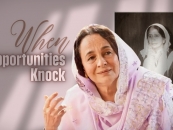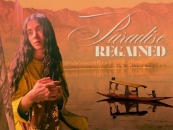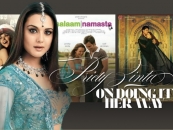-853X543.jpg)
Designed by Desitiny: Pierre Cardin
by HUMRA QURAISHI July 2 2020, 12:44 am Estimated Reading Time: 6 mins, 6 secsHumra Quraishi says Pierre Cardin is perhaps the oldest surviving fashion designer, himself designed by destiny - he turns 98 on 2nd July.
I had met him in 1989, here in New Delhi, when he had specially flown down from Paris to design shirts for the Surajkund Crafts Mela and also to hold fashion shows in India. Mind you, all that designing he did here was for free, he did not charge a penny for it; neither for designing the shirts nor even for the fashion shows.
To the ‘why’ he had told me, during the course of that interview, which was held at the Ashoka Hotel’s presidential suite where he was staying, “Simply because I’m a friend of India’s, its government and its people. It’s tiring for me to travel and follow this hectic schedule but I’m doing so for the sake of friendship and goodwill. I first came here in 1965. In fact, I am the first foreign designer to buy Indian fabric and introduce it to the West.”
And when I’d asked him which particular Indian fabric fascinated him the most, this is what he had to say, “Khadi. In fact, your textiles, the silks and cottons, are beautiful. Silk is more important and valuable than gold. I use a lot of Khadi in the making of my garments.”
And as the interview progressed I’d asked him to give me his views on several things. He answered all my questions patiently, speaking in fluent English, although very heavily accented.
Here are some excerpts from the interview I had done with him.
Besides being good, Indian fabrics are cheap as compared to fabrics from other countries. Do you take advantage of this fact?
No, no. Indian fabric is no longer cheap by the time it reaches us, with heavy customs and air freight charges that we have to pay. I buy it because it is good.
But doesn’t it sadden you that we Indians still do not realize the value of our textiles and grab synthetics instead?
This is no longer true. I am seeing a definite trend towards the use of silk and cotton. Of course, in the West synthetics are no longer fashionable.
You designed shirts for the Crafts Mela. What did you have in mind whilst designing them for Indians?
Well, they are made of Khadi and they’re loose and comfortable, keeping in mind the proportions of the body. The motif on it symbolizes a man and a woman who create a new life.
3.jpg)
Whilst designing what are your priorities and your target consumers?
My basic aim is to make the dress comfortable, and also more wearable for the working woman. I work hard, 18 – 20 hours a day, so I go in for comfortable clothes. Every woman has the right to be fashionable and she should have a desire to buy; and the desire to buy doesn’t happen on its own, you have to create it.
Fashion is very, very important because if there is no fashion, then there is no business and if there is no business then factories will close down, which will mean unemployment for thousands.
Over the last few decades there has been a definite change in the fashion world - in the sense that in the fifties or say in the sixties only the rich had the right to be fashionable. I design for every single woman. I design for the masses.
If you are designing for every single woman then how do you retain that exclusivity that must be attached to your collections?
The exclusivity comes from the fact that I keep changing the designs. I design over 250 new garments every season. You cannot have the same style, clothes. They have to be different like moods, seasons, times…
Which part of the body do you highlight whilst designing?
Nothing in particular. At times I make long and loose dresses, at times short. It all depends. For this coming spring season we are in for long dresses with a lot of material in greens, blacks and browns.
Which type of women attract you?
Every woman can be fascinating. I feel beauty is not enough. There has to be personality. And most important for a woman is to be herself, to respect herself.
But what is your concept of an ideal woman?
It changes. At times a tall woman could fascinate me, attract me. Or at other times a short lady could be charming. But I feel in fashion, the age factor is very important.
Do your women friends always wear outfits designed by you?
No, they wear mine plus from other houses. It is like eating in a restaurant. You are faithful to one but you still frequent the other restaurants.
You have been visiting India right from 1965. Have you noticed any difference in the fashion scene here?
A lot. In 1965, I saw girls in churidars, but now I’m seeing a number of girls wearing pants. Though for evening parties, it is still the sari, which is good because it gives a sense of your country.
2.jpg)
How do you find sari as a dress?
It is not a dress. It is a material. But I really feel hurt when I have to cut it to make dresses.
Any particular Indian dress inspired you?
I’m totally original. And let me tell you that originality is better than copying. All my designs are conceived in my head.
In India only the rich have the privilege of following fashion but the other socio- economic groups cannot do so. How can we break this monopoly?
I design for the masses, the common person. But this story doesn’t hold true only in the Indian context but even in Europe. In the West the elite women of big towns can follow changing fashions but the women in the countryside buy new fashionable garments only once in two or three years or maybe not even then.
Do changing values, from good to bad, affect one’s personality vis-a-vis fashion that hardened women in feminine outfits?
Not really. In fact, you must do what you want to do. Be yourself. If you want to be nude, be nude. Don’t bother what others say.
How important is the value of your name, your label in the business world?
Name or brand is very important, whether it is cigarettes, food, clothes or anything. You buy your favourite brand. But remember my name was not built in a day but it took me 40 years.
You have been called a workaholic. How do you cope with the tensions and pressures?
Yes, I work for hours; say 18 to 20 hours but my work is also my biggest relaxation.




-173X130.jpg)

-173X130.jpg)
-173X130.jpg)



-173X130.jpg)